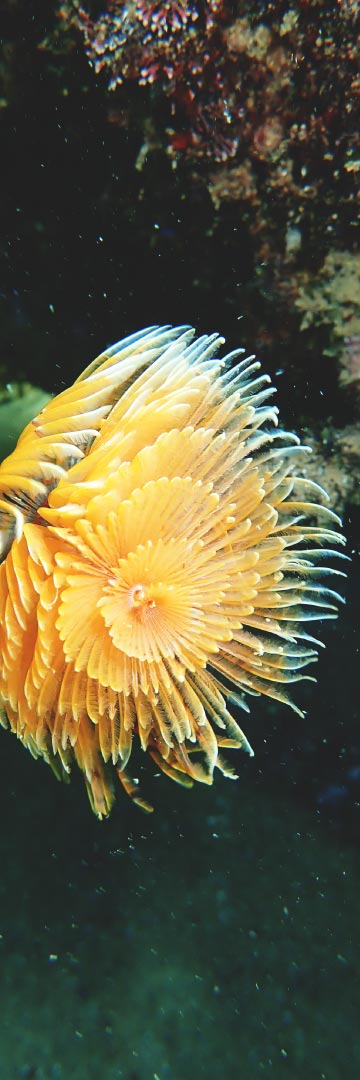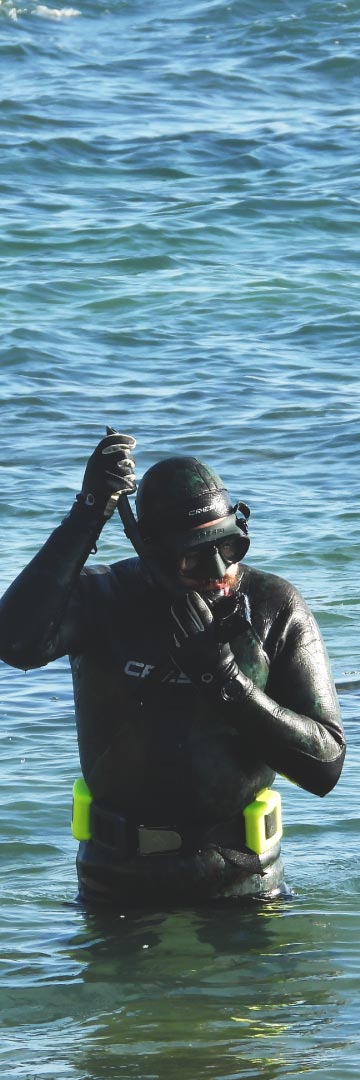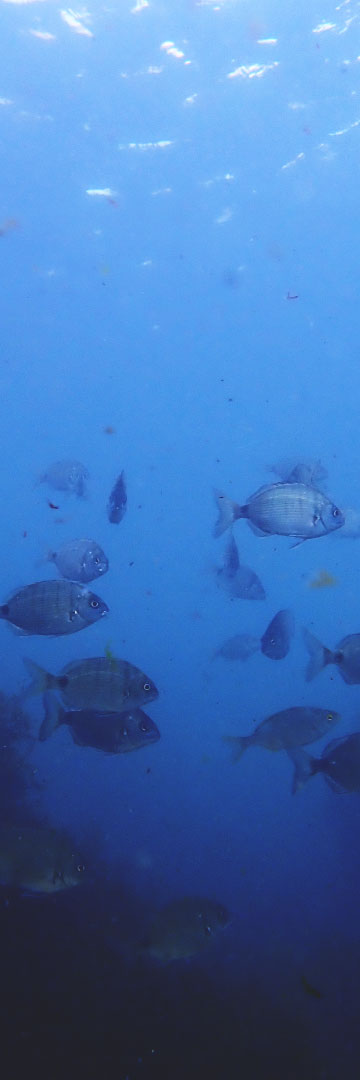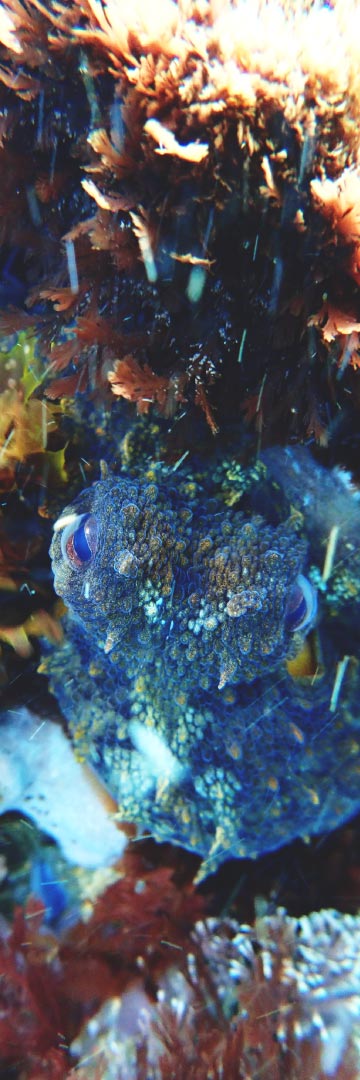
A DISCOVERY PLATFORM SET TO EXPLORE THE ATLANTIC LANDSCAPES OF WESTERN IBERIA
Okeanos is a multiyear project dedicated to understanding and documenting marine biology and ecology in the littoral zone; its central focus lies on the interaction of living organisms with their biophysical environment and human impacts.
THE LITTORAL
ZONE
Determined by the land-sea interface, the marine littoral zone can be defined as an active biome, dominated by cyclic moments of submersion and exposure, strong water motion as well as variable temperature, salinity, and oxygen levels. Here, different geophysical configurations heavily influence the presence of living organisms, giving rise to clear, vertical zonation patterns.
The plants and animals that inhabit this environment constitute an interesting example of life’s adaptation to the volatile — and sometimes turbulent — conditions on Earth’s surface. By coping with dynamic circumstances, from the splash zone to the areas just below the low tide, a myriad of organisms make the best of the situation, thriving on the ensuing, constant nutrient flow.




UNVEILING
THE WAVES
Okeanos seeks to explore littoral landscapes in an immersive, intimate way, traversing the supralittoral, mediolittoral and infralittoral zones to witness the lives and ecological processes that are patent on a variety of habitats — from tidepools on rocky shores, to the permanent water column below the tides.
Each field expedition in this platform is aimed at the creation of both audiovisual and contextual portrayals. The underlying ethos is foremost inquisitive and non-intrusive, allowing our team to unveil a glance of the overall ecological complexity that is present on the surveyed areas: the biodiversity, individual/collective behaviour, interspecific interactions and environmental adaptations.
OPENING THE
OCEAN TO SOCIETY
Okeanos’ output is directed towards the production of documentary content, science based and accessible to a wider audience. It also contemplates the provision of educational materials and programmes, built from the data collected from the field by our team in conjunction with the current, academic understanding of the littoral biology.
Our overarching mission is to present a set of contact points between society and its surrounding marine ecosystems. As a result, we hope to promote nature conservation and habitat protection by introducing people to the stories that constantly unfold by and beneath the waves of the ocean.
GEOGRAPHIC
CONTEXT
The project focus its activities on the central and southern coasts of Portugal, inserted in a wider North-eastern Atlantic context and part of the European regional sea of the Bay of Biscay and the Iberian Coast.
Seeking to witness the ecological processes originated from different littoral geographies, each Okeanos’ expedition is developed on diversified coastal sections. The site selection follows a comparative logic, contrasting a variety of geological, geomorphological, and biophysical contexts, always paying attention to the existing human impacts.
SELECTED
BIBLIOGRAPHY
I
Davies, J., Baxter, J., Bradley, M., Connor, D., Khan, J., Murray, E., Sanderson, W., Turnbull, C. & Vincent, M. (2001), Marine Monitoring Handbook. Joint Nature Conservation Committee 405 pp, ISBN 1 85716 550 0
II
Donoghue, D. N., & Mironnet, N. (2002). Development of an integrated geographical information system prototype for coastal habitat monitoring. Computers & Geosciences, 28(1), 129-141.
III
Godet, L., Fournier, J., Toupoint, N., & Olivier, F. (2009). Mapping and monitoring intertidal benthic habitats: a review of techniques and a proposal for a new visual methodology for the European coasts. Progress in Physical Geography, 33(3), 378-402.
IV
Larsen, P. F., Barker, S., Wright, J., & Erickson, C. B. (2004). Use of cost effective remote sensing to map and measure marine intertidal habitats in support of ecosystem modeling efforts: Cobscook Bay, Maine. Northeastern Naturalist, 11(sp2), 225-242
V
Leston, S., Nunes, M., Rosa, J., Lemos, M. F. L., Ramos, F., & Pardal, M. A. (2014). Prospection, collection, and preservation of marine samples. In Rocha-Santos, T., & Duarte, A. C. (eds). Analysis of Marine Samples in Search of Bioactive Compounds Vol. 65. (pp 15-34). Elsevier.
VI
Meese, Robert J.; Tomich, Patricia A. (1992). Dots on the rocks: a comparison of percent cover estimation methods. Journal of Experimental Marine Biology and Ecology 165.1: 59-73.
VII
Miller, A. W., & Ambrose, R. F. (2000). Sampling patchy distributions: comparison of sampling designs in rocky intertidal habitats. Marine Ecology Progress Series, 196, 1-14.
VIII
Moysés, Danuza Nogueira, Junqueira, Andréa de Oliveira R., Lavrado, Helena Passeri, & Silva, Sérgio Henrique Gonçalves da. (2007). Method for monitoring intertidal communities in a steep rocky shore: a combination of digital image technology and field operational strategy. Brazilian Journal of Oceanography, 55(1), 19-27.
IX
Murray, Steven N., Ambrose, Richard F., & Megan N. Dethier. (2002) Methods for Performing Monitoring, Impact, and Ecological Studies on Rocky Shores. MMS OCS Study 2001-070. Coastal Research Center, Marine Science Institute, University of California, Santa Barbara, California. MMS Cooperative Agreement Number 14-35-0001-30761. 217 pages.
X
Pech, D., Condal, A. R., Bourget, E., & Ardisson, P. L. (2004). Abundance estimation of rocky shore invertebrates at small spatial scale by high-resolution digital photography and digital image analysis. Journal of Experimental Marine Biology and Ecology, 299(2), 185-199.

A DISCOVERY PLATFORM SET TO EXPLORE THE ATLANTIC LANDSCAPES OF WESTERN IBERIA
Okeanos is a multiyear project dedicated to understanding and documenting marine biology and ecology in the littoral zone; its central focus lies on the interaction of living organisms with their biophysical environment and human impacts.
THE LITTORAL
ZONE
Determined by the land-sea interface, the marine littoral zone can be defined as an active biome, dominated by cyclic moments of submersion and exposure, strong water motion as well as variable temperature, salinity, and oxygen levels. Here, different geophysical configurations heavily influence the presence of living organisms, giving rise to clear, vertical zonation patterns.
The plants and animals that inhabit this environment constitute an interesting example of life’s adaptation to the volatile — and sometimes turbulent — conditions on Earth’s surface. By coping with dynamic circumstances, from the splash zone to the areas just below the low tide, a myriad of organisms make the best of the situation, thriving on the ensuing, constant nutrient flow.
UNVEILING
THE WAVES
Okeanos seeks to explore littoral landscapes in an immersive, intimate way, traversing the supralittoral, mediolittoral and infralittoral zones to witness the lives and ecological processes that are patent on a variety of habitats — from tidepools on rocky shores, to the permanent water column below the tides.
Each field expedition in this platform is aimed at the creation of both audiovisual and contextual portrayals. The underlying ethos is foremost inquisitive and non-intrusive, allowing our team to unveil a glance of the overall ecological complexity that is present on the surveyed areas: the biodiversity, individual/collective behaviour, interspecific interactions and environmental adaptations.
OPENING THE
OCEAN TO SOCIETY
Okeanos’ output is directed towards the production of documentary content, science based and accessible to a wider audience. It also contemplates the provision of educational materials and programmes, built from the data collected from the field by our team in conjunction with the current, academic understanding of the littoral biology.
Our overarching mission is to present a set of contact points between society and its surrounding marine ecosystems. As a result, we hope to promote nature conservation and habitat protection by introducing people to the stories that constantly unfold by and beneath the waves of the ocean.
GEOGRAPHIC
CONTEXT
The project focus its activities on the central and southern coasts of Portugal, inserted in a wider North-eastern Atlantic context and part of the European regional sea of the Bay of Biscay and the Iberian Coast.
Seeking to witness the ecological processes originated from different littoral geographies, each Okeanos’ expedition is developed on diversified coastal sections. The site selection follows a comparative logic, contrasting a variety of geological, geomorphological, and biophysical contexts, always paying attention to the existing human impacts.
SELECTED
BIBLIOGRAPHY
I
Davies, J., Baxter, J., Bradley, M., Connor, D., Khan, J., Murray, E., Sanderson, W., Turnbull, C. & Vincent, M. (2001), Marine Monitoring Handbook. Joint Nature Conservation Committee 405 pp, ISBN 1 85716 550 0
II
Donoghue, D. N., & Mironnet, N. (2002). Development of an integrated geographical information system prototype for coastal habitat monitoring. Computers & Geosciences, 28(1), 129-141.
III
Godet, L., Fournier, J., Toupoint, N., & Olivier, F. (2009). Mapping and monitoring intertidal benthic habitats: a review of techniques and a proposal for a new visual methodology for the European coasts. Progress in Physical Geography, 33(3), 378-402.
IV
Larsen, P. F., Barker, S., Wright, J., & Erickson, C. B. (2004). Use of cost effective remote sensing to map and measure marine intertidal habitats in support of ecosystem modeling efforts: Cobscook Bay, Maine. Northeastern Naturalist, 11(sp2), 225-242
V
Leston, S., Nunes, M., Rosa, J., Lemos, M. F. L., Ramos, F., & Pardal, M. A. (2014). Prospection, collection, and preservation of marine samples. In Rocha-Santos, T., & Duarte, A. C. (eds). Analysis of Marine Samples in Search of Bioactive Compounds Vol. 65. (pp 15-34). Elsevier.
VI
Meese, Robert J.; Tomich, Patricia A. (1992). Dots on the rocks: a comparison of percent cover estimation methods. Journal of Experimental Marine Biology and Ecology 165.1: 59-73.
VII
Miller, A. W., & Ambrose, R. F. (2000). Sampling patchy distributions: comparison of sampling designs in rocky intertidal habitats. Marine Ecology Progress Series, 196, 1-14.
VIII
Moysés, Danuza Nogueira, Junqueira, Andréa de Oliveira R., Lavrado, Helena Passeri, & Silva, Sérgio Henrique Gonçalves da. (2007). Method for monitoring intertidal communities in a steep rocky shore: a combination of digital image technology and field operational strategy. Brazilian Journal of Oceanography, 55(1), 19-27.
IX
Murray, Steven N., Ambrose, Richard F., & Megan N. Dethier. (2002) Methods for Performing Monitoring, Impact, and Ecological Studies on Rocky Shores. MMS OCS Study 2001-070. Coastal Research Center, Marine Science Institute, University of California, Santa Barbara, California. MMS Cooperative Agreement Number 14-35-0001-30761. 217 pages.
X
Pech, D., Condal, A. R., Bourget, E., & Ardisson, P. L. (2004). Abundance estimation of rocky shore invertebrates at small spatial scale by high-resolution digital photography and digital image analysis. Journal of Experimental Marine Biology and Ecology, 299(2), 185-199.


